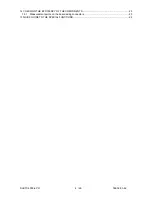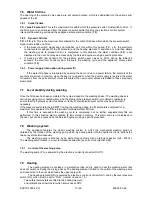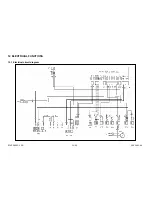
SOI/TD 2005-2 PR
/26
599 36 83-66
13
7.6 Water fill time
The opening of the solenoid valve has a pre-set overall duration, which is subdivided into the various sub-
phases of the fill:
7.6.1 Static fill time
T.S. = max 90 seconds:
This is the maximum time within which the pressure switch must switch to FULL. If
the FULL signal is not received from the pressure switch within this time, the electronic control system
interrupts the washing cycle and the appliance enters alarm condition [
1 0
].
7.6.2 Dynamic
fill
time
T.D. = T.S. x 3:
This is the maximum time allowed for the entire fill phase within which the pressure switch
signal must stabilize on FULL.
•
If the pressure switch signal does not stabilize on FULL within this period (T.S. x
3
), the electronic
control system switches off the fill solenoid (and the heating element, if switched on), and then allows
the washing cycle to proceed until it is completed. In this situation, the alarm condition [
F 0
] is not
displayed to the user, but may be accessed by the Service Engineer using a specific procedure.
•
If, during a 2600 rpm dynamic fill, the pressure switch never closes on FULL during the initial 60
seconds, the electronic control system interrupts the washing cycle and the appliance enters alarm
condition [
1 0
].
7.6.3 Power supply interruption during water fill
If the water fill phase is interrupted by opening the door or due to a power failure, the contents of the
counters are stored in memory; when the door is re-closed or when the power supply is restored, the water
fill resumes from the point at which it was interrupted; the new counter values are added to those previously
memorized.
7.7 Level stability during washing
Once the fill phase has been completed, the cycle proceeds to the washing phase. The washing phase is
carried out using cold or heated water, and the status of the pressure switch is monitored constantly to
ensure that the hydraulic system functions correctly. Water replenishment cycles may be performed if
necessary.
If the pressure switch returns to EMPTY during the washing phase, the fill solenoid is energized for a
maximum time equivalent to
T.S. x 3
(maximum allowable total fill time).
If this time is exceeded, the washing cycle is completed, but no further supplementary fills are
performed. In this situation, alarm condition [
F 0
] is stored in memory. This alarm code is not displayed to
the user, but can be accessed by the Service Engineer using a specific procedure.
7.8 Washing
system
The appliance features the classic washing system in which the mechanical washing action is
obtained by the rotation of the washing pump which, by ducting water into the hydraulic circuit, actions the
two spray arms simultaneously.
The washing pump is actioned by an asynchronous motor with a start-up capacitor (3µF– 450VL).
The washing pump rotates in a counter-clockwise direction (seen from the impeller side).
7.8.1 Control of the washing pump
The washing pump (PL) is powered by the electronic control (connector D3-D11).
7.9 Heating
The heating element is enclosed in a protective tube, and is used to heat the washing water (but
does not switch on during the drying phase). The heating element is fitted to the outlet of the washing pump
and connected to the duct which feeds the upper spray arm.
The heating element (RR) is powered by electronic control (connector A1)
and by
the level pressure
switch (RL), which must be set to “FULL” (contact closed on 1-3).
Two safety thermostats are fitted to the heating element:
-
an automatic-reset thermostat which intervenes at 98ºC












































